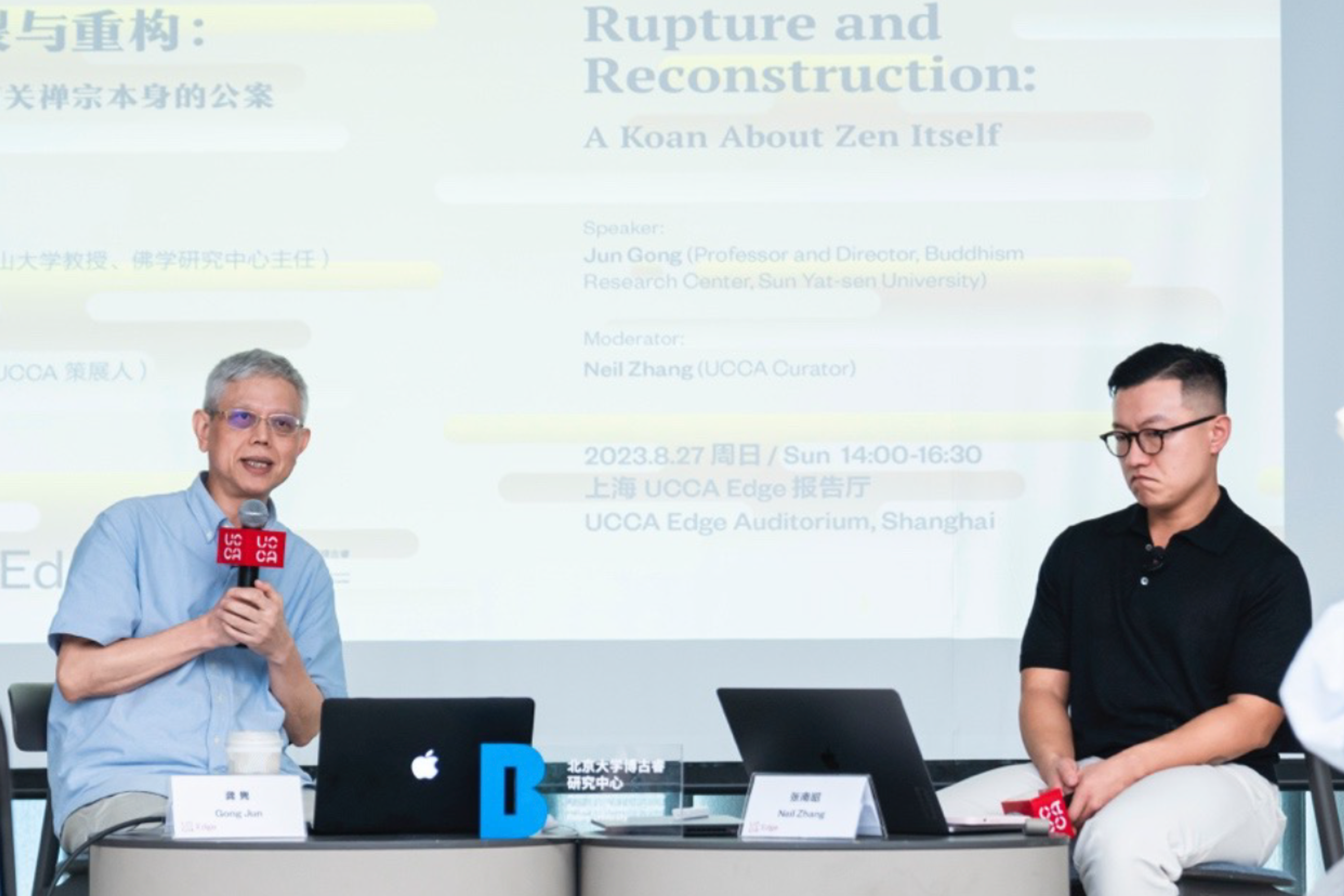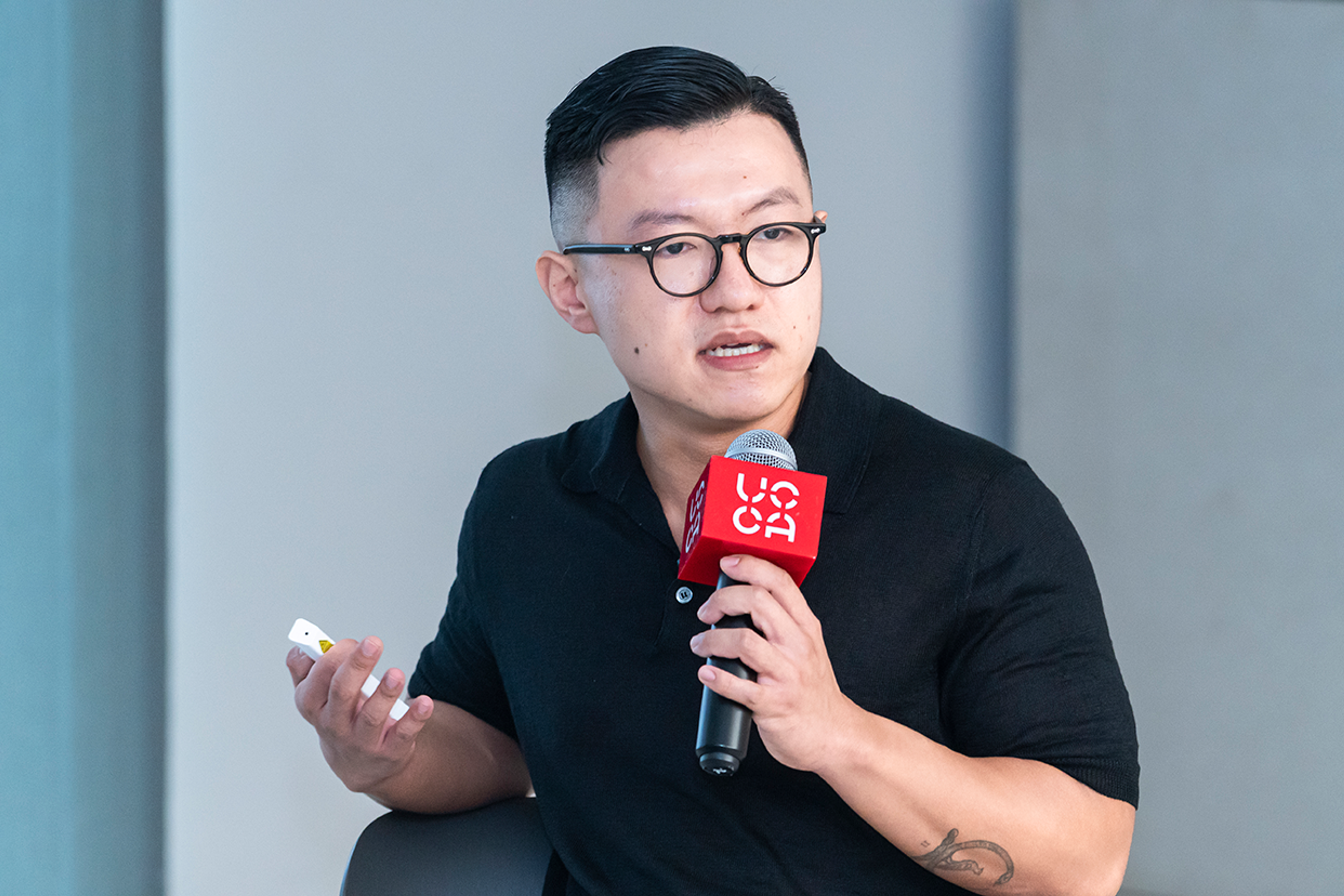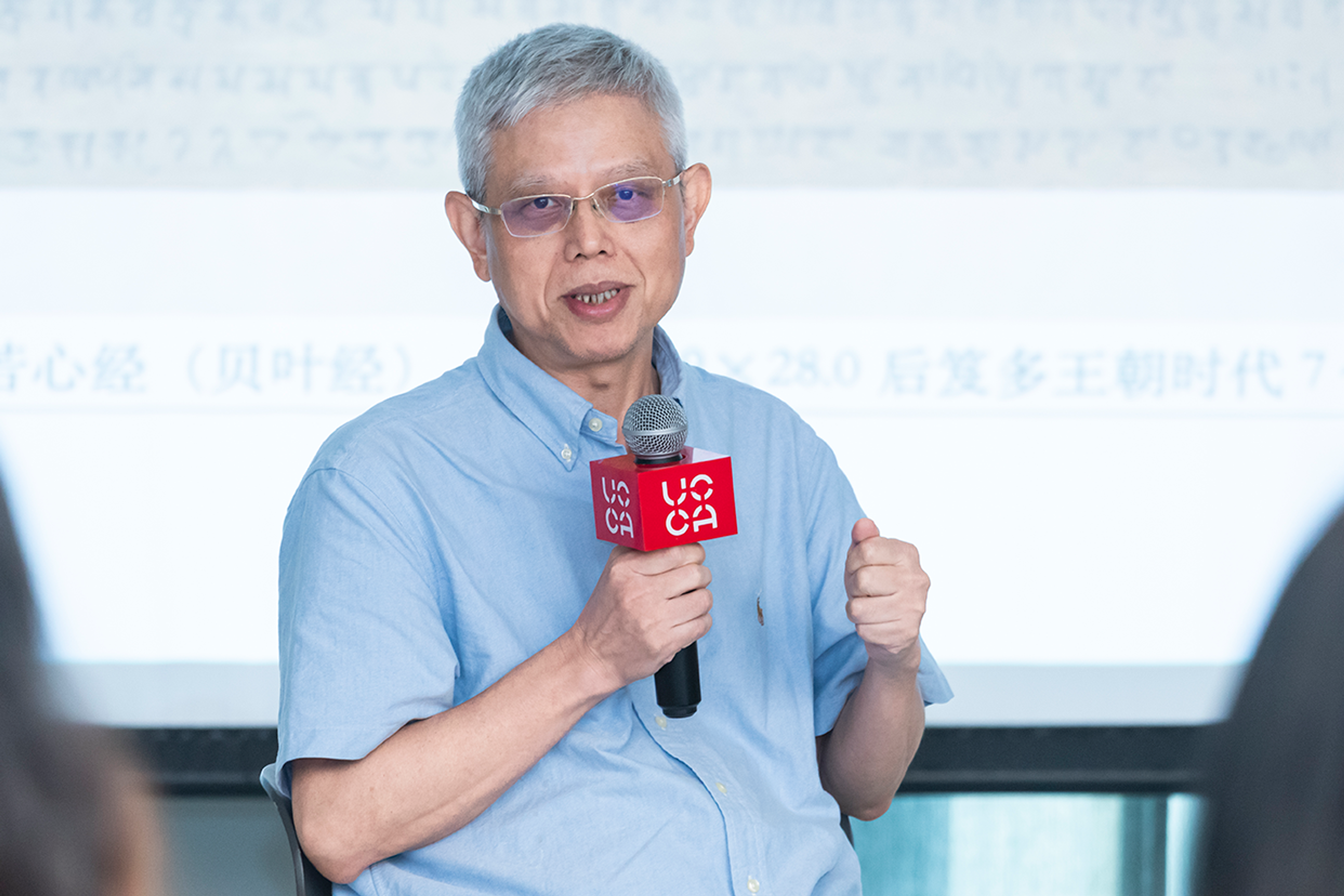Rupture and Reconstruction: A Koan About Zen Itself

The second session in the dialogue lecture series "Rupture and Reconstruction: Multiple Perspectives on Modernity," jointly organized by Berggruen Research Center, Peking University and the UCCA Center for Contemporary Art, was held at UCCA Edge in Shanghai on August 27, 2023. Gong Jun, a Berggruen scholar and professor at the Center for Buddhist Studies at Sun Yat-sen University, was the keynote speaker at the event, and UCCA curator Zhang Nanzhao served as the moderator. Their discussions centered around the efforts made by D.T. Suzuki to promote Mahayana and Zen Buddhism into the Western world, Western responses to these efforts, and the impact of Suzuki’s Zen studies in the English-speaking world in the 1980s on the Chinese intellectual community.

Overloaded Connotations of Zen
Today, Zen has evolved into an overloaded concept. In the academic realm, it appears to be a research phase that has already passed, and in the eyes of the public, it has woven together a cultural amalgamation with elements from both Japan and China. Various conflicting connotations and understandings make "Zen" exhibit a kind of complexity and multifaceted nature that cannot be easily captured.
An initial contradiction arises from the mismatch between Karesansui (literally “dried mountains and rivers”) and non-Zen courtyards. An iconic art form of Zen Buddhism, Karesansui can be found in Kongobuji Temple of the Koyasan sect of Japanese Shingon (Tantra) Buddhism. In Japanese Buddhism, Shingon Buddhism and Zen Buddhism stand in stark contrast to each other regarding their primary deities, ritual systems, and more. So, the question arises: Why does an art form closely associated with Zen appear in a core temple of Shingon Buddhism?
The second paradoxical case is the attachment of modern and contemporary art to Zen. On the one hand, Zen is an integral part of modern art, and the studies of Zen represented by D. T. Suzuki and his teaching experience at Columbia University in the 1950s have had a profound impact on many modernist artists and art historians, including John Cage and Arthur Danto. On the other hand, Zen seems to be a misconception often imposed on artistic creations. During a conversation with Tate curator Sook-Kyung Lee, the artist Lee Ufan mentioned that his works are consistently described as Zen Buddhism, even though he neither understands Zen nor Buddhism. Where does the audience's impression of Zen-like qualities in artwork come from?
The third case of contradiction is an anecdote in the history of Zen Buddhism. The Guggenheim Museum's 2018 group exhibition "One Hand Clapping" claimed that the theme was directly taken from a koan (a short story, enigma or dialogue that a teacher uses to teach his student lessons in Zen Buddhism) of the Tang Dynasty (618-907) that transcends logic. However, the illogical appearance of the Zen koan is largely due to D.T. Suzuki's influence in the Western academia, and the koan "One Hand Clapping" was created by Japanese monk Shirain Keitsuru in the Edo period. In a modern art exhibition curated in the 21st century, why does Zen still present itself as the tradition of Zen studies in the first half of the 20th century and even earlier?
The fourth contradiction lies in the developmental history of koan itself. The examination of pre-Song documents has led us to pay attention to textual records such as Wumenguan and Zen Master's Records, which resemble the form of later koan writing. The existence of these textual records suggests that the formation and popularity of koan can be traced back to no earlier than the Song Dynasty (960-1279). Within Zen Buddhism, there were also many sects such as Caodong that did not use koan as a method of practice. How could this relatively late written form come to seemingly represent an intrinsic and unshakeable component of Zen Buddhism’s essence and status?

Pre-modern, Modern and Anti-modern Interpretations of "Zen"
The debate over Zen has roots dating back to the early 20th century. One of the most famous debates on Zen took place between Hu Shi and D.T. Suzuki. Using philological methods, Hu compared records in the existing ancient book Master Caoxi's Record in Japan with the purported history of Zen Buddhism transmission as derived from the Altar Sutra. He found that the assertion that Saichō, the founder of the Tendai sect of Japanese Buddhism, visited the Tang Dynasty in 803, the 19th year of the Zhenyuan reign, appeared incongruent with various other historical records which indicate that it was impossible for Saichō to have access to Master Caoxi's Record at that time. Consequently, Hu Shi criticized Zen Buddhism for being rife with "forgery and fraud." The cross-temporal comparison of philology and the unearthing of Buddhist documents in Dunhuang debunked many beliefs about Buddhism at that time. Based on this empirical approach to literature research, it is not difficult to understand why Hu Shi expressed disappointment with D.T. Suzuki's characterization of Zen Buddhism is "irrational and illogical." This debate constitutes an important historical backdrop for D.T. Suzuki's Zen studies in the 20th century.
In fact, the fundamental disagreement between Hu Shi and D.T. Suzuki in their approach to Zen research stems from their differing attitudes towards Buddhism and religion as a whole. They still appreciated each other's efforts with regards to collating, collecting, and integrating literature, which manifested in their mutual assessments of each other. Hu Shi criticized that Suzuki's research ignored the methods of documentary and historical criticism, viewing his work more as "preaching" than research; Suzuki believed that Hu did not distinguish between "matters related to Zen" and "Zen itself.” He argued that even thorough research into documentary materials only clarified matters related to Zen and not Zen itself. This indicates that the disagreement between the two is not in the use of documentary materials, but whether to give these materials a primary status.
During that time, disagreements and confrontations did not occur only in the East. Another important historical backdrop to D.T. Suzuki's Zen studies was the research paradigm of Western Buddhist scholars at that time. Influenced by traditional philology and comparative linguistic approaches, the European academic community in the 19th century had already formed a research paradigm centered on Sanskrit, Pali and Tibetan sutras, focusing on the study of classical Buddhism. They advocated for returning to original Buddhism to genuinely study the Buddhist philosophy, and claimed that Mahayana Buddhism, and even East Asian Buddhism as a whole, was considered heterodox or marginal within Buddhism. This was a significant challenge to East Asian researchers who were accustomed to centering their studies around Mahayana Buddhism.
This challenge explains the approach D.T. Suzuki took towards his Buddhist studies in the 20th century. Although Suzuki's fame is now often associated with Zen Buddhism, Zen was not the original subject of his research. His early writings and translations focused on Mahayana Buddhism. He translated Mahāyānaśraddhotpāda-śastra (Treatise on the Awakening of Faith in the Mahayana), a classic of East Asia’s Mahayana Buddhism, into English. Subsequently, he wrote the Outline of Mahāyānaśraddhotpāda-śastra, in an effort to introduce this classic into the field of Western classical Buddhist studies. Suzuki aimed to demonstrate to the Western academic community, which had downplayed and even criticized Mahayana Buddhism at that time, that East Asia’s Mahayana Buddhism was another pinnacle in the development of Buddhism.
However, his struggle did not achieve the desired results. From the traditional perspective of classical Buddhist studies in Europe at that time, Suzuki's linguistic and textual critical ability was debatable, and his translation of the Sanskrit version of Mahāyānaśraddhotpāda-śastra was considered subpar. Suzuki's efforts in this phase thus ended in failure.
By the 1920s, Suzuki turned to Zen studies, which arguably marked his second attempt to contend with the mainstream discourse of Western Buddhist studies. He realized that in order for studies of Mahayana Buddhism to have impact in the European academic community, he had to turn to another Buddhist tradition with East Asian characteristics—the Rinzai sect of Zen Buddhism. He began introducing Zen ideas to the West, which in turn earned him acclaim, and Western scholars widely regard Suzuki as the first person to bring Eastern Zen to the West.
One of the reasons why D.T. Suzuki's second phase of research generated wide resonance was that he drew from existing Western knowledge concepts. Unlike the earlier studies of Mahayana Buddhism, his interpretation of Zen in the second phase was highly strategic. He no longer simply translated and introduced the Buddhist classics and Buddhist studies of the East to the West; instead, he focused on highlighting the anti-logical and irrational characteristics of Zen, positioning Zen on the opposite side of traditional Western rationalism. This garnered immediate interest from Western researchers. D.T. Suzuki went beyond the domain of "experience" in the Eastern sense, leveraging on the experiential concept of religion from the American pragmatic philosophy trend at that time. He also invoked the mystical aspects of ancient Western philosophy and Christianity to explain Zen. By doing so, he successfully transformed Eastern Buddhism, which Western scholars had previously regarded with skepticism, an accessible source of counter-thought. His way of interpreting "experience" also profoundly influenced later generations’ understanding of Zen.
The Western academia’s response to D.T. Suzuki's Zen studies can also be broadly divided into two phases, with the 1970s and 1980s as the boundary. The first phase mainly consists of follow-up responses to Suzuki’s studies by many writers and researchers, such as Alan W. Watts, who authored The Way of Zen. For a time, Suzuki became an indispensible figure in Western Buddhist research, and whenever Zen was discussed, Suzuki’s name would inevitably be mentioned, making him an idol in the intellectual world. His influence even extended beyond the academic circles, and even the popularity of Zen in the early American hippie movement owed a debt to Suzuki's influence.
However, after the 1980s, a new paradigm of Zen history research emerged in Western academia, leading to a significant shift in the attitude towards D.T. Suzuki’s work. This shift was characterized by criticism and reflection, essentially marking the twilight of Suzuki’s idol status. Interestingly, one of the main drivers of this wave of critical reflection can be traced back to the debate between Hu Shi and Suzuki. Their debates and the subsequent discovery of Buddhist scriptures in Dunhuang greatly influenced Japanese scholar Seizan Yanagida. Later, Yanagida reorganized and critiqued early historical documents of Zen Buddhism using modern methodologies. Along with further research on the disputes between Northern Buddhism and Southern Buddhism and the rising doubts about the mystical narratives in the history of Zen Buddhism, these studies greatly prompted this philosophical shift in Western Zen scholars.

Zen in China
In contrast with the surging criticism on the other side of the continent, D.T. Suzuki's ideas widely popular in China during the 1980s. In that decade, China's philosophical academia experienced a resurgence, and a large number of foreign scholars' philosophical research was introduced to the country, including translations of Suzuki’s work. Suzuki's Zen research framework and methods exerted a widespread impact on the Chinese mainland’s academic community, represented by works such as Ge Zhaoguang's Zen Buddhism and Chinese Culture, which shaped the understanding of Zen throughout China in the 1980s.
Interestingly, almost all Chinese translations related to D.T. Suzuki during this period were based on English versions, and there were few studies based on Suzuki's Japanese works in the Chinese mainland. It can be said that Suzuki's theories and ideas, since their introduction into the history of Chinese philosophy, had already taken on a “Westernized” discourse of Zen. Li Zehou's History of Ancient Chinese Thought includes an article on "Zhuangzi, Metaphysics[KT1] , and Zen", which interprets Zen Buddhism in the context of Chinese philosophical traditions including Taoist philosophy and Wei and Jin metaphysics. However, this interpretation method does not significantly depart from the framework of the English translations of D.T. Suzuki's works. This shows how Suzuki's influence on the philosophical academia of the Chinese mainland in the 1980s formed a sharp contrast with the circles of Buddhist studies in Japan and Europe at that time.
Interestingly, in addition to philosophical academia, the art community of the Chinese mainland was also heavily influenced by D.T. Suzuki's Zen studies. In the 1980s and 1990s, there was a cultural and artistic resurgence, and artists were eager to explore new thoughts and concepts, looking for various theories and ideas to support their works and creations. For this reason, Zen studies repeatedly drew attention from mainland Chinese artists such as Xu Bing and Gu Wenda. The publication of Suzuki's Zen and Japanese Culture in mainland China sparked a wave of new conceptualizations themed "Zen and X." Zen was linked with various subjects such as art, tea ceremony, and architecture, presenting Zen in a complex way within a postmodern framework. In addition, many mainland Chinese artists regarded Zen as “a kind of experience, instead of philosophy, science or art.” There were even some misconceptions, such as regarding Huineng as the founder of Zen Buddhism and the Platform Sutra of the Sixth Patriarch as the fundamental scripture of Zen. All of these clearly show the influence D.T. Suzuki’s interpretations.
Looking back at the 20th century, we should note that D.T. Suzuki wasn’t the only one that tried to introduce East Asia’s Mahayana Buddhism to the West. The Chinese Buddhist master Taixu, a symbol of Buddhist reform, was also engaged in the spread of Mahayana Buddhism early on. He also proposed establishing an international Buddhist academy to promote exchanges and understanding of Buddhism between countries. Taixu attempted to collaborate with Japanese monks and Buddhist scholars to expand the influence of Eastern Buddhism in the Western world, but these efforts met with limited success. Later, Master Taixu may have realized that the heterogeneity of Chinese and Japanese cultures posed a challenging barrier. The concept of Eastern Buddhism largely carried the essence of Japanese culture, although Zen Buddhism had originated in China. The failure of Chinese monks to propogate Mahayana Buddhism has formed an thought-provoking historical resonance with the disconnect between contemporary mainland academic and art circles and the spiritual traditions of Zen and Chinese culture.
In any case, the successes and failures of D.T. Suzuki and Master Taixu repeatedly illustrate how different strategies of transmission and interpretation have influenced the historical position of Zen in the West and later in the East. Whether it is placing Zen in the context of pragmatism and mysticism in order to gain affinity with Western readers, portraying Zen as illogical and irrational in order to use it as an antidote to modernity, or regarding Zen as a unique perspective amidst myriad new thoughts, all of these approaches constitute thought-provoking cases of the advancement of East Asian Buddhist spiritual and cultural traditions in the 20th century.